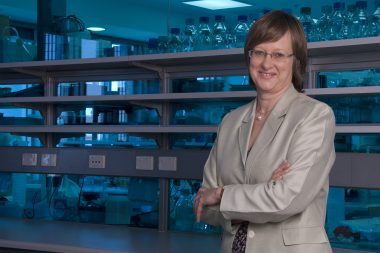“Think broadly, don’t be siloed within your own discipline; listen to what’s happening in the community.” Professor Julie Bines.
Australia’s brightest scientists have always smashed it out of the park in the fight against the deadly Rotavirus.
Science icon Dr Ruth Bishop and her team changed the lives of children around the world when they discovered the Rotavirus in the 1970’s … their subsequent vaccine has saved 100,000 lives in this country alone since 2007.
Another brilliant woman, Professor Julie Bines is now taking the research to the next level, and for that we love her…
Friends, meet Julie…
Martine Harte: Julie thank you for your good work. You and your team are developing a new Rotavirus vaccine to deliver ‘orally’ to babies at birth, why is that such a significant breakthrough?
Professor Julie Bines: Well Rotavirus is a killer of children worldwide, it’s the most common cause of severe dehydrating gastroenteritis in children. It not only causes suffering in children but also up to half a million deaths of children each year.
Whilst can do a lot in terms of improving sanitation, we know that some viruses such as Rotavirus are very elusive to control by those normal measures and vaccination is by the far the most effective way of preventing severe disease.
Providing it orally at birth is the perfect time, in a non-invasive way to be able to provide that protection.
The World Health Organisation recommends all infants receive a vaccine, as part of routine immunisation schedule, yet 70% of the world’s children still lack access why’s this?
Professor Julie Bines: Well vaccines do cost money, particularly in very low-income countries it’s a matter of prioritising where very precious dollars are spent and sometimes vaccines are just not affordable.
Sometimes those vaccines are very difficult to get out into the country, in war zones, in conflict zones.
Providing a vaccine that can be affordable, easily delivered, stored and delivered at birth is important because mums and babies are more likely to be with a health care provider.

Florey Medal winner Dr Ruth Bishop, centre bottom row.
You’ve now been handed the baton from the amazing Dr Ruth Bishop, how does that make you feel?
It’s a very big responsibility but it’s actually lovely to try and spread the legacy.
Ruth gave us a challenge: there is this organism that’s incredibly common and around everywhere and we all get it – we don’t have to be in a developing country – we all get Rotavirus at some stage of our lives, usually before five years of age.
To ask ourselves, ‘How can we provide an affordable vaccine, to increase the possibility of protection in children in not only Australia but worldwide?’ is a great challenge.
We want to beat this bug!
So, I understand the research in is the final stages of clinical trials and early results have been promising is that right?
Professor Julie Bines: Well we’ve completed phase one and phase two studies, The current study is taking it to a region in Indonesia where the vaccine will really be tested in a village with a high burden of Rotavirus disease so it will be a really good test and we’re waiting anxiously for the results.
If the vaccine is successful in final stages of trials and introduced, it’s potential is mind blowing isn’t it?
It has huge potential in combination with other vaccines and treatments available to save hundreds of thousands more babies’ lives who are still dying from rotavirus every year. (official figures are more than 200,000 deaths of children under 5, globally, every year).
Why is this week’s symposium (held in Melbourne for the first time) so crucial?
Professor Julie Bines: It’s a really important acknowledgment of the work Melbourne scientists have played in the Rotavirus story and our important contribution to child health.
40 years on since that discovery, ten years since we’ve had a vaccine, it’s a really nice time to reflect and identify the challenges that exist to improve the reach and protection.
Murdoch Childrens Research Institute is one of the top five paediatric research centres in the world, your findings shape health policy – must feel pretty good going to work?
Look it’s exciting to think each day you go to work and you might be able to do something to help a child or children and that’s a great privilege.
And I think the Murdoch Childrens Research Institute and the University of Melbourne is a really lovely partnership, which combines the essential breadth of academic research and clinical work.
What’s your best advice for work/life integration (we don’t talk about “balance” around here) ….
I believe it’s thinking broadly, not to be siloed within your own discipline; listen to what’s happening in the community.
What are the things that are important to people? In the field I work in, what are the clues you get from clinicians? What are the problems we should be addressing to make children’s lives better?
I’m a clinician, I work with children who are ill and they are the greatest source of information to help you solve their problem.
I always think the children provide the questions we need to answer, not the other way around.
WANT MORE?
Discover more about Australia’s incredible Murdoch Childrens Research Institute here.
Got another few minutes? Hear from fabulous Ambassador for Women and Girls Natasha Stott Despoja here.
Check our out interviews with other amazing Australian scientists over on the home page.
Or learn an easy way you and/or your friends can support Women and Children in Crisis in your patch here.
Before you go, Engaging Women has just been selected by the National Library of Australia for collection, sign up for more goodness here. Just one email a month.
